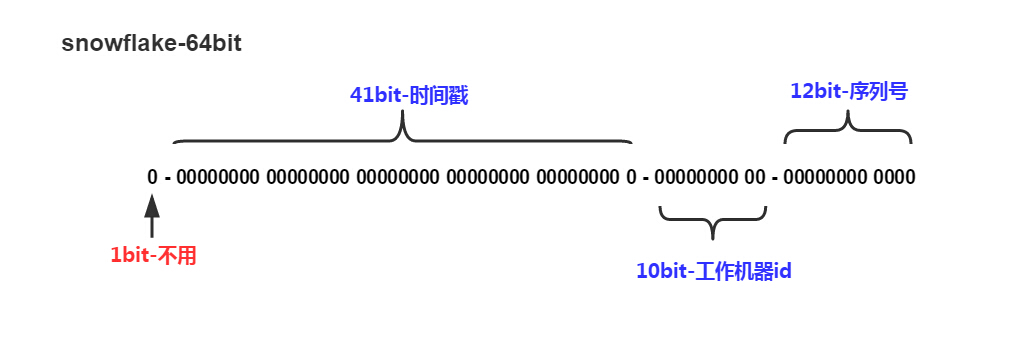简介
这个是根据twitter的snowflake来写的.这里有中文的介绍.

如上图所示,一个64位ID,除了最左边的符号位不用(固定为0,以保证生成的ID都是正数),还剩余63位可用.
下面的代码与图中的位数分配略有不同,除了中间部分10bit工作机器id不变,时间戳和序列号的位数是可以根据自己的需求变化的,就是说,你可以把中间的工作机器ID往左挪一挪,或往右挪一挪.
代码
/// <summary>
/// 64位ID生成器,最高位为符号位,始终为0,可用位数63.
/// 实例编号占10位,范围为0-1023
/// 时间戳和索引共占53位
/// </summary>
public sealed class IdCreator
{ long timestamp = 0;//当前时间戳
long index = 0;//索引/计数器
long instanceID;//实例编号
int indexBitLength;//索引可用位数
long tsMax = 0;//时间戳最大值
long indexMax = 0; static IdCreator _default = new IdCreator(); /// <summary>
///
/// </summary>
/// <param name="instanceID">实例编号(0-1023)</param>
/// <param name="indexBitLength">索引可用位数(1-32).每秒可生成ID数等于2的indexBitLength次方.大并发情况下,当前秒内ID数达到最大值时,将使用下一秒的时间戳,不影响获取ID.</param>
/// <param name="initTimestamp">初始化时间戳,精确到秒.当之前同一实例生成ID的timestamp值大于当前时间的时间戳时,
/// 有可能会产生重复ID(如持续一段时间的大并发请求).设置initTimestamp比最后的时间戳大一些,可避免这种问题</param>
public IdCreator(int instanceID, int indexBitLength, long? initTimestamp = null) { if (instanceID < 0)
{ //这里给每个实例随机生成个实例编号
Random r = new Random(); this.instanceID = r.Next(0, 1024);
} else
{ this.instanceID = instanceID % 1024;
} if (indexBitLength < 1)
{ this.indexBitLength = 1;
} else if (indexBitLength > 32) { this.indexBitLength = 32;
} else
{ this.indexBitLength = indexBitLength;
}
tsMax = Convert.ToInt64(new string('1', 53 - indexBitLength), 2);
indexMax = Convert.ToInt64(new string('1', indexBitLength), 2); if (initTimestamp != null)
{ this.timestamp = initTimestamp.Value;
}
} /// <summary>
/// 默认每实例每秒生成65536个ID,从1970年1月1日起,累计可使用4358年
/// </summary>
/// <param name="instanceID">实例编号(0-1023)</param>
public IdCreator(int instanceID) : this(instanceID, 16) {
} /// <summary>
/// 默认每秒生成65536个ID,从1970年1月1日起,累计可使用4358年
/// </summary>
public IdCreator() : this(-1) {
} /// <summary>
/// 生成64位ID
/// </summary>
/// <returns></returns>
public long Create() { long id = 0; lock (this)
{ //增加时间戳部分
long ts = Harry.Common.Utils.GetTimeStamp() / 1000;
ts = ts % tsMax; //如果超过时间戳允许的最大值,从0开始
id = ts << (10 + indexBitLength);//腾出后面部分,给实例编号和缩引编号使用
//增加实例部分
id = id | (instanceID << indexBitLength); //获取计数
if (timestamp < ts)
{
timestamp = ts;
index = 0;
} else
{ if (index > indexMax)
{
timestamp++;
index = 0;
}
}
id = id | index;
index++;
} return id;
} /// <summary>
/// 获取当前实例的时间戳
/// </summary>
public long CurrentTimestamp
{ get
{ return this.timestamp;
}
} /// <summary>
/// 默认每实例每秒生成65536个ID,从1970年1月1日起,累计可使用4358年
/// </summary>
public static IdCreator Default
{ get
{ return _default;
}
}
}代码说明
使用时,需要new一个IdCreator的实例,然后调用Create()方法,生成一个ID号.需要把IdCreator的例实赋给一个静态变量,以保证ID号的唯一性.如果是分布式部署,需要给IdCreator的构造函数传递instanceID参数,每一个部署都要有一个不同的值,范围为0-1023.

v63积分商城特色功能:支持三种物品类型的发放1.实物:实物领取需要填写收货信息:2.虚拟:可以自定义用户领取需要填写的信息3.卡密:自动发放,后台能够查看编辑卡密状态支持三种种物品发放方式1.兑换:2.拍卖3. 抽奖兑换拍卖信息可以以帖子的形式自动发布当设定了“兑换拍卖自动发帖版块“ ID时,发布商品会自动在改ID版块生成帖子用户兑换或者出价后都会以跟帖的
 0
0

构造函数中的indexBitLength参数,代表图中最右边的'序列号'的长度,不再固定为12bit,范围为1-32.剩下的可用位,就留给了时间戳.
注意:IdCreator类的时间戳是按秒计的. 如果想改成毫秒,只需要将代码long ts = Harry.Common.Utils.GetTimeStamp() / 1000;改成long ts = Harry.Common.Utils.GetTimeStamp();即可.
示例代码
IdCreator c=new IdCreator(0,16); var id=c.Create();

每个人都需要一台速度更快、更稳定的 PC。随着时间的推移,垃圾文件、旧注册表数据和不必要的后台进程会占用资源并降低性能。幸运的是,许多工具可以让 Windows 保持平稳运行。

Copyright 2014-2025 https://www.php.cn/ All Rights Reserved | php.cn | 湘ICP备2023035733号